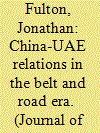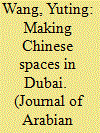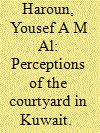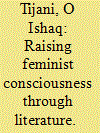|
|
|
Sort Order |
|
|
|
Items / Page
|
|
|
|
|
|
|
| Srl | Item |
| 1 |
ID:
172442


|
|
|
|
|
| Summary/Abstract |
In the summer of 2018 China and the United Arab Emirates (UAE) upgraded their bilateral relationship to a comprehensive strategic partnership, China’s highest level of diplomatic relations. This follows a trajectory of deepening multifaceted ties that has been steadily becoming strategically important for both states, especially as China’s Belt and Road Initiative (BRI), launched in 2013, results in deeper engagement in the Middle East. This article examines the features of the China-UAE relationship, providing an original historical framework that explains the context of relations through four periods prior to the BRI: indifference, hostility, transition, and interdependence. It then analyzes developments in the bilateral relationship during the early stages of the BRI, demonstrating that the UAE has become a key partner for China in its Middle East policy.
|
|
|
|
|
|
|
|
|
|
|
|
|
|
|
|
| 2 |
ID:
172441


|
|
|
|
|
| Summary/Abstract |
This article traces some of the patterns of investment and financial flows between China and the Arab Gulf states. Building on an emerging literature of Gulf-China relations, and Middle East-China relations more generally, it identifies specific flows of investment in the Gulf states, export destinations of Gulf energy products, and the institutional networks of development finance between the Gulf and China. Based on the specific demands of the Arab Gulf states and their shared efforts to diversify their economies away from oil and gas dependency, the research suggests that the current orientation toward China, and Asia more broadly, is a bridge strategy to create a next-generation energy market and future market access in expected areas of consumer growth. The Gulf and China need each other, but the strategies developing now are also oriented toward future growth in India and the Horn of Africa and in transport and trade flows. This future growth will cement the Arab Gulf states as central to developing economies and our shared global economy.
|
|
|
|
|
|
|
|
|
|
|
|
|
|
|
|
| 3 |
ID:
172440


|
|
|
|
|
| Summary/Abstract |
In the last half a decade or so, both China and the Gulf region have achieved phenomenal growth experiences in their own rights. While this success is applauded, marginal progress, going forward, proves to be more challenging. Seizing the opportunity, however, both sides can cooperate to complement each other to further open new horizons to their respective societies. While China’s product markets need diversity, and factories require oil, and its grand projects look for financing sources, the Gulf is in search of diversifying their markets, profitably investing their accumulated financial wealth, and employing the youth. Both sides have more than sufficient reasons to join forces for a “win-win” proposition.
|
|
|
|
|
|
|
|
|
|
|
|
|
|
|
|
| 4 |
ID:
172436


|
|
|
|
|
| Summary/Abstract |
This article traces the legal and political-economic disputes surrounding the construction of the Basra port in the era of World War I and the Mandate. Although the port was nominally an Iraqi institution, British colonial authorities vested it with a jurisdictional reach that actually extended beyond its own physical boundaries. It grew to encompass local municipalities, multinational corporations, and central state authorities on either side of the porous river border between southern Iraq and Iran. While this anomalous spatio-political arrangement facilitated British colonial extraction in Iraq and a wider imperial project in the Gulf, it also repeatedly broke down amid competing claims to space and sovereignty by the Anglo-Persian Oil Company and the Pahlavi state. The history of these conflicts helps bring together the often siloed historiographies of Iraq and the Gulf, and position both in larger scholarly debates on the political geography of borderlands, infrastructure, and empire.
|
|
|
|
|
|
|
|
|
|
|
|
|
|
|
|
| 5 |
ID:
172443


|
|
|
|
|
| Summary/Abstract |
This paper examines the spatial expansion of Chinese communities in the city of Dubai as the result of the strengthening economic ties between China and the Arab Gulf states over the last two decades and the diversification of economy in the Gulf region. Beginning with a brief account of the history of Chinese migration into the UAE, this paper sketches out the contour of Chinese spaces in a rapidly growing global city. This paper contributes to the development of a holistic assessment of the impact of China’s rise in the region and contextualizes the intricate relationships between China and the Arab World. It calls for more ethnographic studies of Chinese communities in the Arab Gulf states and emphasizes the need to broaden the traditional foci and methodology in the study of relations between China and these states.
|
|
|
|
|
|
|
|
|
|
|
|
|
|
|
|
| 6 |
ID:
172439


|
|
|
|
|
| Summary/Abstract |
The courtyard was once found in every house in Kuwait. It was a multi-purpose open space where the entire family would gather and socialize. Some courtyards had a tree or shrub, and most would have a well. This all changed after the discovery of oil. In the 1950s Kuwait underwent rapid and unprecedented urbanization and within a decade was transformed from a small shaikhdom to a modern regional metropolis. Kuwaitis were forced into a new lifestyle. The Kuwaiti house changed from the courtyard house, sustainable, private and inward-facing, into the modern villa, full of new technology, and facing outward toward the street. In this study, the courtyard is used as a vehicle to examine a number of socio-cultural, economic and political aspects of the move towards modernity in the domestic built environment and away from the vernacular and sustainability. Investigating several questions that have been raised in prior research, this study aims to identify the qualities and uses of the courtyards that people might value and use in the contemporary house. A mixed-method approach has been employed to provide qualitative data to support and complement quantitative findings. The article’s ultimate aim is to add to our understanding of how how people have dealt with and adapted to the collision between traditional concepts and modernity. Among the findings is the existence of a surprising disconnect between past realities and current perceptions, even about what a courtyard is.
|
|
|
|
|
|
|
|
|
|
|
|
|
|
|
|
| 7 |
ID:
172437


|
|
|
|
|
| Summary/Abstract |
Through close textual analysis of Hidāya al-Sālim’s (1936–2001) “Kharīf bilā maṭar” (1972) and Najwā Hāshim’s (b. 1960) “Ḥumā fī layla sākhina” (1986), this article examines how literature has been used as a means of raising feminist consciousness in the Arabian Gulf region. I argue that these two short stories, among others, can be situated within the “authentic realist” literary corpus famously championed by the Anglo-American women’s liberation movement of the 1970s–80s. Enhancing the stories’ consciousness-raising features are the facts that they both were written in a historical period when the women’s liberation movement was gaining momentum across the world, and that each of them was first published in a local magazine/newspaper. Moreover, the authors depict not just the ways through which some women of their own generation in particular have been victims, but also, the necessity of female agency (individual and collective) in achieving liberation from patriarchal domination.
|
|
|
|
|
|
|
|
|
|
|
|
|
|
|
|
| 8 |
ID:
172438


|
|
|
|
|
| Summary/Abstract |
The Syrian civil war prompted a new wave of religious discourse in Saudi Arabia as the Saudi government and its clerics expressed support for the Sunni protesters in Syria. The issues of jihad and Sunni groups fighting in Syria received significant clerical attention; the Saudi ʿulamāʾ of various political persuasions, including “activists” and “quietists”, commented on the events in Syria. Following the rise of ISIS as the war progressed, the ʿulamāʾ became themselves the subject of scrutiny for allegedly providing the foundations for extremism in Syria. Both the rhetoric of the clerics, as well as Saudi Salafi religious traditions more broadly, came under immense attack domestically and internationally. This article examines how the Saudi clerics dealt with these criticisms. It analyses the rhetoric and actions of the clerics in relation to ISIS’s brand of Salafism, both theologically and politically. It finds that the Saudi ʿulamāʾ of various political persuasions are contesting claims to Salafism, resulting in heated debates and attempts to reconstruct Saudi religious traditions.
|
|
|
|
|
|
|
|
|
|
|
|
|
|
|
|
|
|
|
|
|